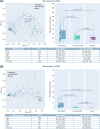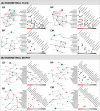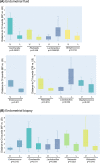Endometrial microbiota composition is associated with reproductive outcome in infertile patients
- PMID: 34980280
- PMCID: PMC8725275
- DOI: 10.1186/s40168-021-01184-w
Endometrial microbiota composition is associated with reproductive outcome in infertile patients
Abstract
Background: Previous evidence indicates associations between the female reproductive tract microbiome composition and reproductive outcome in infertile patients undergoing assisted reproduction. We aimed to determine whether the endometrial microbiota composition is associated with reproductive outcomes of live birth, biochemical pregnancy, clinical miscarriage or no pregnancy.
Methods: Here, we present a multicentre prospective observational study using 16S rRNA gene sequencing to analyse endometrial fluid and biopsy samples before embryo transfer in a cohort of 342 infertile patients asymptomatic for infection undergoing assisted reproductive treatments.
Results: A dysbiotic endometrial microbiota profile composed of Atopobium, Bifidobacterium, Chryseobacterium, Gardnerella, Haemophilus, Klebsiella, Neisseria, Staphylococcus and Streptococcus was associated with unsuccessful outcomes. In contrast, Lactobacillus was consistently enriched in patients with live birth outcomes.
Conclusions: Our findings indicate that endometrial microbiota composition before embryo transfer is a useful biomarker to predict reproductive outcome, offering an opportunity to further improve diagnosis and treatment strategies. Video Abstract.
© 2021. The Author(s).
Conflict of interest statement
IM, DPV, MGM, DB, CG, DV and CS are partially employed by Igenomix R&D. The rest of the authors declare that they have no competing interests.
Figures







References
-
- Aitchison J. The statistical analysis of compositional data. London: Chapman & Hall, Ltd; 1986.
-
- Almonacid DE, Kraal L, Ossandon FJ, Budovskaya YV, Cardenas JP, Bik EM, Goddard AD, Richman J, Apte ZS. 16S rRNA gene sequencing and healthy reference ranges for 28 clinically relevant microbial taxa from the human gut microbiome. PLoS One. 2017;12(5):e0176555. doi: 10.1371/journal.pone.0176555. - DOI - PMC - PubMed
-
- Benner M, Ferwerda G, Joosten I, van der Molen RG. How uterine microbiota might be responsible for a receptive, fertile endometrium. Hum Reprod Update. 2018. 10.1093/humupd/dmy012https://www.ncbi.nlm.nih.gov/pubmed/29668899. - PubMed
Publication types
MeSH terms
Substances
LinkOut - more resources
Full Text Sources
Other Literature Sources

